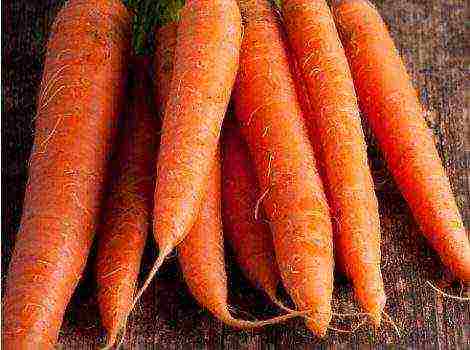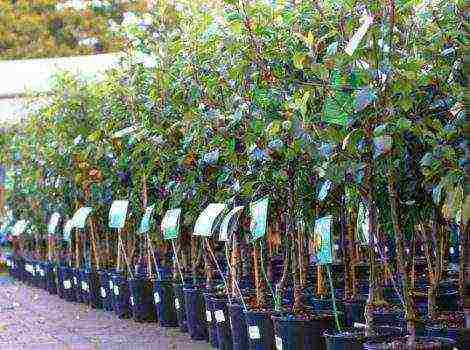Content
- 1 Description of late cabbage
- 2 Growing features
- 3 The best varieties of late-ripening cabbage
- 4 Varietal variety of white cabbage
- 5 Most Popular
- 6 The best varieties of late cabbage
- 7 Recommendations for growing a crop
- 8 Gardeners reviews
For salting and long-term storage until spring, winter (or late-ripening) varieties of cabbage are most suitable. It is them that summer residents prefer to grow in order to prepare enough of this useful vegetable for the winter to feed the whole family.
Growing white cabbage
Description of late cabbage
Many late varieties have been bred. They differ mainly in the duration of ripening. While early varieties take three months from germination to fully ripen, mid-season varieties may take four months, then some varieties of late cabbage mature only six months after the start of growth from seeds.
Description of late cabbage
This long wait is rewarded:
- equally long shelf life;
- high yield of varieties;
- excellent transportability of heads of cabbage;
- readiness to preserve all valuable substances, taste and textural properties during salting, pickling and fermentation.
By the way! Varieties intended for long-term storage improve their palatability over time. In addition, in cabbage, unlike other vegetables and root crops, nitrates do not accumulate during the time it is stored.
Cabbage
The second difference between different types of cabbage ripening in terms of maturation is agricultural technology. In general terms, it is similar not only for all cabbages, but also for many crucifers. But the timing of sowing, germination, planting and some growth conditions differ in detail in late cabbage from its mid-ripening and early-ripening "relatives".
By the way! Some varieties of late-ripening cabbage can stay intact, under appropriate conditions, until the next harvest.
Growing features
Growing cabbage in a greenhouse
In different regions, depending on the climate, the seeds of late cabbage varieties are planted at different times. But always, in all climatic zones, this is a seedling method of growing. For late varieties, seedlings are grown at home (in extreme cases, in a heated greenhouse or greenhouse). In the southern regions, it is possible to sow seeds on a special seedling bed under a film cover.
Stimulation and disinfection of seeds
Seeds
Before sowing late cabbage seeds, they need to be disinfected. Soaking in hot water is sufficient for disinfection. The temperature should not be higher than + 45 ° С. It is necessary to keep cabbage seeds in water for a quarter of an hour, placing them first in a rag bag.
Disinfection of seeds
How to keep the required temperature in the container for a certain time?
- Put a dish of water on the heater (after checking the temperature of its heating in advance for half an hour).
- Put the container in another container, pouring water into it, ten degrees hotter (a kind of water bath, just not on fire).
- Disinfect seeds in a multicooker on the "Yogurt" mode.
Important! The heating procedure will not only destroy the microbes that may be inside the seed, but will also contribute to the speedy germination by activating the growth point of the embryo.
Disinfection of seeds with potassium permanganate
After disinfection by heating, the seeds must be quickly cooled by lowering them for one minute under cold running water.
Soaking the seeds in a fertilizer solution will help accelerate germination and make the seedlings even more uniform. It can be any mineral complex. It is best to take a regular nitrophoscope. The proportions for the preparation of the solution are 5 g of granules per 500 ml of water. Room temperature water. Dissolve thoroughly. Keep seeds for 12 hours.
Preparation of seedling containers and soil
Cabbage dives well, so it can be grown initially in any convenient or available containers. If pots are available, use pots. There are boxes, sow in boxes.
Peat seedling pots
It is more convenient to plant cabbage on a ridge or in a greenhouse from individual pots with a diameter of about 8 cm. By the time they move to the garden, the seedlings should have four adult leaves.
The soil for sowing cabbage does not need heavy. Peat is traditionally used. If possible, part of the humus is mixed with part of the sod land, sand can not be added. Both peat and mixed substrate must be seasoned with wood ash. About a tablespoon is used per liter of substrate. The ash is sieved before this. Then it is thoroughly mixed with the soil.
Soil for cabbage seedlings
If you have not steamed the soil mixture, then be sure to spill it with Trichophyte solution or pink potassium permanganate solution
Sowing
You can sow late cabbage seeds at the end of February. It can take up to 60 days before planting seedlings in the garden. The latest sowing dates for late varieties are mid-March. Sowing later in the middle lane is impractical, the heads will not have time to ripen.
Advice! If you are late with sowing late-ripening varieties, sow mid-ripening ones. Some mid-season varieties, for example, "Gift", are stored for up to four months, have good data for canning and can be used fresh.
Spread the seeds
Add seeds
Sowing takes place in shallow grooves, about 2 cm deep. The distance between the crops in the box is 5 cm.When two full-fledged leaves appear, the seedlings will have to be thinned so that the distance between the seedlings is at least 5 cm.If you are sowing in a pot, place 3-4 seeds at the corners of an imaginary square, on top of the soil. Fill on top with a two centimeter layer of peat. Crops are watered and covered with foil.
Place the bowl in a plastic bag and keep the sowing until germination at a temperature of about 20 ° C
After germination, which appears on the 5-7th day, the film is removed immediately and is no longer used.
Watering cabbage seedlings
Preparing the cabbage bed
Preparing the cabbage bed
Late varieties need a lot of sunlight, heat and moisture for the heads of cabbage to mature fully. Only finally ripe heads of cabbage can be stored all winter until summer. Therefore, the landing site is chosen open. The soil is fertilized with organic matter in the fall. Cabbage loves organic fertilizers - this is the best fertilizing option for this plant. Late cabbage especially needs fertilization of the soil. Up to 7 kg of rotted organic matter is used per 1 m². Can be fertilized with plant compost. But animal organic matter in addition, in the form of a solution, should be used for pre-plant feeding and for periodic feeding, of which at least three are carried out during the growing season.
Transfer
Seedling cabbage
At the end of April, holes are dug in a dug ridge according to the number of seedlings. Seedlings move into moist soil, with a moist clod, do not deepen. Watering is necessary plentiful. The first feeding is carried out on the twentieth day after planting.
Cabbage planting scheme
Planting cabbage in the ground
Planting cabbage seedlings
Fill the hole with water
The hole is kept free of weeds. The soil is loosened. After the beginning of the formation of the outer stump, the plant must be spud.
The best varieties of late-ripening cabbage
There are not so many varieties of cabbage, unlike other garden vegetables. Against several hundred varieties of tomatoes, cucumbers, peppers - only a few dozen early, medium and late cabbage varieties. Some of them, moreover, were bred back in the USSR from numerous hybrids, so they cannot be called the best. The most popular, most frequently and successfully cultivated are the following late varieties.
"Aggressor"
Aggressor is a popular hybrid variety
Marked "F1", it is a hybrid in the first generation. It can be grown in any region. Its characteristic features are delayed development at the stage after planting seedlings; unpretentiousness and ease of plant care.
By the way! This variety grows with little or no maintenance. In any case, you do not need to look after him as carefully as for his brothers. You can "forget" to water, feed (withstands a lack of nitrogen and drought).
Aggressor F1
Color - green with blue. There is a waxy coating. The structure of the head of cabbage is of high density. The hard, knocked down fruit reaches five kilograms. Grown within four months. After 120 days from germination, it reaches full ripeness. Almost no cracking occurs, prolonged cleaning is possible almost until the first frost.
The variety is resistant to black leg, not affected by fusarium, thrips, not susceptible to late blight. One of the best for fermentation, stored in heads of cabbage for five months.
Video - Cabbage "Aggressor F1"
"Mara"
One of the most popular varieties of Belarusian selection. The growing season is long - up to 165 days. Heads of average weight - 4 kg. But the taste is exceptional. Used for fermentation whole, heads, kept fresh for about eight months, until early May. Differs in high productivity.
White cabbage. Variety "Mara"
Bluish waxy bloom on the thick outer leaves is pronounced. The variety is grafted with resistance to rot.
"Moscow"
White cabbage "Moscow" late
This is a giant variety. The heads can be up to ten kilograms. Ripens, however, in just 130 days. It is considered one of the most productive varieties. The surface color is green-gray. The inside of the section is white with yellowness. The taste is not just good - it is excellent. Lots of sugars, ascorbic acid, minerals.
By the way! Able to endure temperature drop down to -6 ° C ... 8 ° C. Therefore, the dates of disembarkation and harvesting can be shifted to an earlier (spring) and later (autumn) time.
Moscow cabbage
With a dense consistency, it is juicy. Resistant to cracking and most cruciferous diseases. Only slugs and aphids need processing.
Stored at + 5 ° C for 9 months or more.
"Amager"
"Amager"
The variety is ideal for fermentation and the production of any blanks. The heads are small - up to five kilograms. The density is increased. The color is green-gray with a bloom. White inside. There is resistance to root rot and fungal infections.
By the way! It is a cold-tolerant variety, but it does not tolerate heat well and reacts negatively to drought. Therefore, it needs additional watering.
The growing season of the variety lasts 160 days. Average shelf life is up to six months. Therefore, this variety is best used to create winter stocks of pickles. Perfectly transported, not prone to damage, does not crack, cleaning can be done mechanically.
"Megaton"
Cabbage "Megaton f1"
The earliest among the late hybrids, after the leader of the "Aggressor". The growing season is within four months. The head of cabbage grows dense, weighing up to 5 kg. This is a Dutch hybrid, and the breeders took care of the "brainchild" as much as possible, providing it with immunity not only to diseases, but also to insect damage.
Excellent transport capabilities. Quite high taste parameters. It is not stored for long - five months. Used for fermentation. Needs frequent watering and an increased rate of mineral fertilizing.
"Snow White"
Cabbage "Snow White" (late)
A late variety, it is considered universal, since it is suitable both for storage for eight months, and for all types of salting and canning, as well as for fresh consumption.
By the way! High healing properties of this variety of cabbage and its increased nutritional qualities are noted. It is considered beneficial for children as it supplies many of the nutrients needed by a growing body.
Fully ripe forks reach 4 kg. The growing season is 160 days. Leaves of beautiful turquoise color, white dense inside. Not damaged by delayed harvest and transportation.
"Valentina"
"Valentina"
A very popular variety among gardeners of the middle lane. Domestic hybrid. It ripens for a long time - up to 180 days. The weight characteristics of a head of cabbage do not exceed 4 kg. Stored for 8 months. But with all these "ordinary" qualities, "Valentina" is distinguished by outstanding taste qualities. It is characterized by high sugar content, crispness, and fork density. It can be used in all cabbage "hypostases". But best of all, besides perfect storage, cabbage tolerates pickling.
White cabbage "Valentina"
"Kolobok"
"Kolobok"
Also a popular hybrid with perfectly rounded five-kilogram heads that ripen within 150 days. Wax bloom is pronounced. The middle is snow-white. A very dense head of cabbage. Stored for 7 months. Can be used for fermentation. This variety, with such "alright", one-to-one heads of cabbage, is distinguished by high marketability, simultaneous ripening and ease of harvesting. Does not require specific maintenance. It is susceptible to cabbage diseases and pests.
"Sugarloaf"
Cabbage variety "Sugarloaf"
The speaking name of this late variety indicates its high sugar content. There is absolutely no bitterness in it, so it is used mainly fresh. Not only organic sugars are contained in it in large quantities, but also many minerals, and a number of vitamins, led by ascorbic acid.
Sugarloaf giant cabbage
By the way! Resistance to fusarium, bacterial diseases, keel and an eight-month shelf life contributes to the popularity of the variety.
After 160 days from the beginning of the growing season, the heads of cabbage gain a mass of 3.5 kg. This is quite a bit when you consider that some varieties grow three times heavier. But the nutritional value is taken into account when choosing a cultivar for cultivation, therefore Sugarloaf is not in the last place among the popular late cultivars of white cabbage.
"Lezhky"
"Lezhky"
This hybrid, named eloquently for its properties (high keeping quality), has, nevertheless, a very small weight, and, accordingly, size, heads of cabbage. The maximum up to which the forks grow is 3 kg. Ripens for 155 days. Has above average palatability immediately after harvest. Then, during storage, they rise significantly. The variety can be stored until June, a full nine months. Moreover, they even begin to ferment and preserve it not immediately after collection, but in the middle of the shelf life. At this time, around February, the heads of cabbage reach the highest sugar content.
"Triumph"
"Triumph"
An extremely late ripening hybrid, ripening 175 days. The mass of a head of cabbage does not exceed 4 kg. Recommended by summer residents for cultivation for a long and good keeping quality. Storage is possible up to 8 months.It tolerates all types of canning perfectly, keeping the vitamin composition unchanged. High juice content. Above the average density of a head of cabbage. Not prone to fusarium wilt. The yield is strong.
"Filibuster"
"Filibuster"
This "pirate" variety is a mid-late hybrid. It is preferred for a relatively short ripening period of 130 days. Small heads of cabbage - 3.5 kg. Shelf life to late varieties does not hold out, shelf life is no longer than 5 months. But you can ferment and preserve immediately after harvesting. Taste characteristics are equally high for both fresh and canned products.
Table. The timing and duration of the main stages of growing popular late varieties of white cabbage
| "Aggressor" | 50 | 120 | 5 |
| "Mara" | 60 | 165 | 8 |
| "Moscow" | 55 | 130 | 9 |
| "Amager" | 60 | 160 | 6 |
| "Megaton" | 55 | 130 | 5 |
| "Valentina" | 60 | 180 | 8 |
| "Kolobok" | 55 | 150 | 7 |
| "Sugarloaf" | 60 | 160 | 8 |
| "Lezhky" | 60 | 155 | 9 |
| "Triumph" | 60 | 175 | 8 |
| "Filibuster" | 50 | 130 | 5 |
5 best ways to store cabbage
Video - Planting late cabbage
.
One of the healthiest vegetables is cabbage. This vegetable is very versatile in its use. In winter, late varieties of cabbage are actively used.
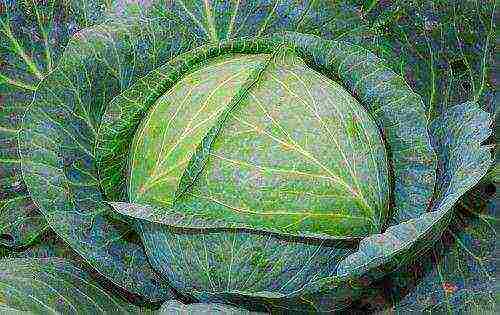
Late varieties of cabbage are not afraid of autumn frosts
Features of late cabbage
Late white cabbage species are endowed with the following qualities:
- yield rate;
- ability to preserve (up to 9 months);
- the possibility of mechanized harvesting;
- use for fermentation;
- breeding for resistance to diseases, pests.
The ripening period of late cabbage from sowing the seed to harvesting takes 190 days. But such varieties are not afraid of autumn frosts. Under these conditions, late cabbage heads form faster. Such cabbage is afraid of frost in the spring, so they must be grown in seedlings.
Depending on the region, the process of sowing the seed takes place at different times.
It is important to disinfect the seed before sowing.
What are the best varieties of late cabbage
The best cabbage varieties are those that keep well. These vegetables can be stored until mid-spring. But there are varieties that can be preserved until the new cabbage is harvested. It is important that the density of the vegetable and the flavoring properties hardly change.
It is believed that hybrid species are best suited for long-term storage.
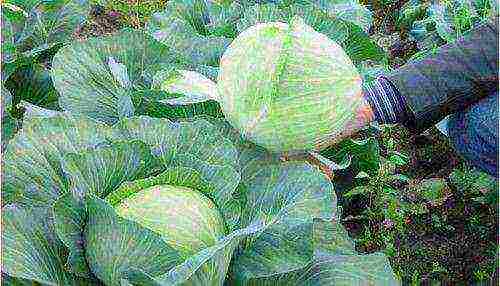
Aggressor is a popular hybrid variety
Aggressor
It is a late hybrid variety of white cabbage. A very popular Dutch species grown in all regions of our country. The slow ripening of the fruit forms the density of the head of cabbage. Doesn't require any thorough maintenance. It can grow even under not so good conditions, without cracking. The selection of this variety, the selection is developed for the resistance of the vegetable to many diseases: late blight, black leg, fusarium. The aggressor is resistant to aphids, caterpillars, cruciferous flea beetles. This is the best vegetable for pickling and storage.
Mara
In the Belarusian selection, it is the best variety. The ripening period takes 170 days. Ripe fruits weigh 4 kilograms. The color of the head is dark green with a visible waxy coating. Mara is a white-headed species and can be stored until the first days of May. Has excellent resistance to rot and damage. An excellent variety for fermentation.
Moscow
An excellent choice of white cabbage for storage. A feature of this variety is its high yield. The weight of a ripe head of cabbage can reach up to 10 kilograms. The head is dense, overall flattened.
Stored for a long time (until the first fresh harvest). The breeders have provided this variety with high resistance to keel disease, which makes it possible to have a good harvest.
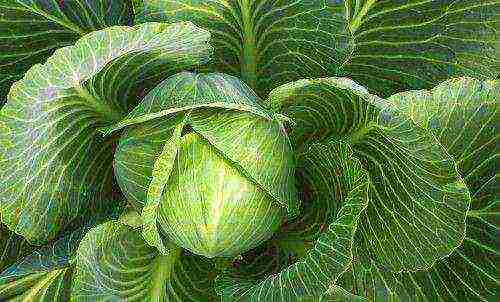
A feature of the Moscow cabbage variety is its high yield.
Amager
The best choice of white cabbage for pickling. Amager is a juicy, high-yielding variety. The head ripens up to five kilograms of mass, dense. Among similar white-headed species, this is an important property.
The upper part of the head of cabbage is endowed with a green tint, but when cutting amager, the shade becomes white. It is excellently stored in winter, well preserved when moved. It is resistant to rot and fungi. The vegetation stage lasts 160 days. Amager prefers moisture and needs to be periodically fed with mineral fertilizers.
This variety is unsuitable for fermentation, because after ripening it has a coarse leaf quality and a bitter taste, although closer to spring, the bitterness disappears.
Snow White
A practical variety of late cabbage. It lasts up to eight months. Experts point to the good healing qualities of the vegetable. Very useful for children. But, it is recommended to store at a temperature not lower than +8 degrees.
Megaton F1
This is the fastest maturing species among the late varieties - up to 130 days. The mass of one ripe fruit can be up to five kilograms. During the selection process, Megatons F1 developed very good resistance to fungal diseases and insect pests. The variety is convenient for transportation.
Megaton F1 is a Dutch cabbage, but quite popular in many countries. The shelf life is about five months. During the growing period, it is necessary to comply with watering norms and feed with organic fertilizers. Usually organic matter is introduced in the first days of growth and 35 days after planting seedlings in open ground.
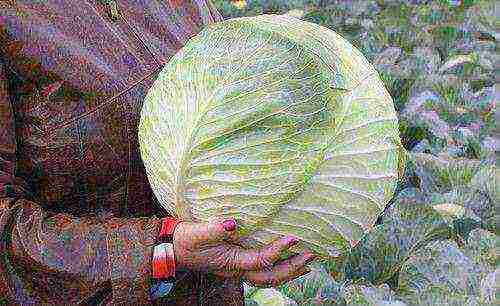
Megaton F1 is the fastest maturing late variety
Gingerbread man
A high-yielding cabbage variety that ripens 150 days after sprouting. Round heads with good density, weighing up to 5 kg. It has a selection for resistance to cracking. The head of cabbage is green on top, and white when cut.
The gingerbread man is endowed with resistance to bacteriosis, fusarium leaf wilting to rot... A good choice for winter storage and fermentation. With the right content, this species can persist until May. Seeds are sown in mid-April.
After ripening, Gingerbread man has a bitter taste, but over time, the bitterness disappears.
Wintering
Is the best domestic breeding for storage. The growing season lasts four months. The fetus is preserved for up to eight months. Waste during storage has a low percentage. The selection of the variety is resistant to cracking, necrosis throughout storage. Can be used for fermentation.
Based on this information, each gardener can choose which varieties of late cabbage to use for their garden and their own purposes in the winter: preference for pickling or storage.
Subscribe Be aware of new products on our site
White cabbage is an incredibly healthy vegetable with a rich vitamin and mineral composition. This explains its popularity among gardeners. The cultivation rules are not complicated, but the basis for the yield depends on the choice of the variety.
Varietal variety of white cabbage
In the old days, there was really a shortage of seed material due to limited supplies from the near and far abroad, therefore, the seeds were often harvested from the usual varieties.
For more than 20 years, the situation has changed radically, and the varietal assortment of many gardeners continues to consist of 2-3 positions. And in vain, because new developments have no less valuable qualities, which consist in resistance of cabbage to diseases and pests.
This is especially important when you consider that the moisture-loving plant literally attracts insects and fungi.
This article discusses early, mid-season and late-ripening varieties of a popular vegetable with a description that will expand the variety of crops grown in your garden and in the Urals and in the middle lane.
Most Popular
The variety of cabbage is selected not only taking into account the winter and climatic characteristics of the region, but also by appointment... The mineral and vitamin composition of each plant is different, but it is also influenced by the conditions of agricultural technology and the type of soil.
In order to choose the appropriate option it was easier, the varietal assortment is divided into groups, united by a common feature.
The best late varieties of cabbage for long-term storage
Aggressor Is a mid-late hybrid developed by breeders from Holland. Differs in minimal care and resistance to fusarium, thrips damage.
Vegetation lasts up to 120 days, you can sow seeds directly on an open bed. A ripe vegetable weighs 3-5 kg. Shelf life and processing - up to 5 months.
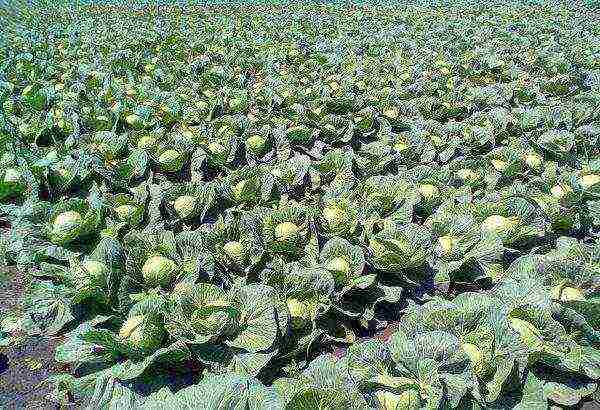 Aggressor
Aggressor
Amager - late cabbage with a ripening period 120-147 days... The heads are round-flat green, sometimes with a bluish tinge, weight about 3-4 kg.
When planting, the scheme is used: 3-4 plants per 1 m2. For six months, the nutritional value and presentation are preserved. Weather cataclysms and violation of the watering regime do not violate the density of the structure and the integrity of the head.
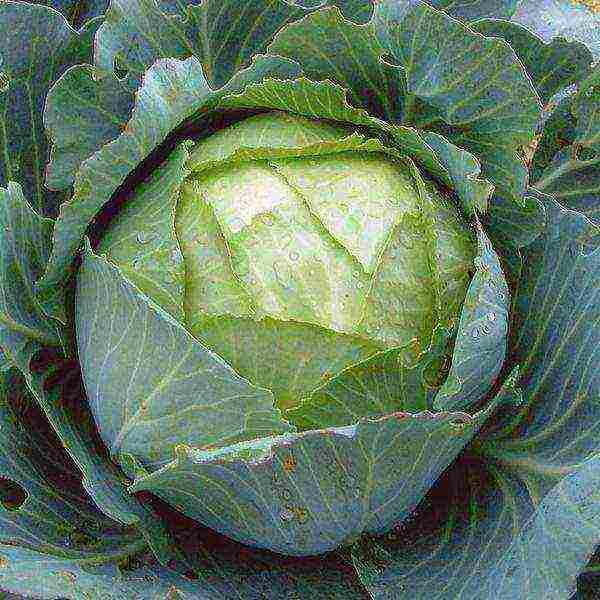 Amager
Amager
Valentine - growing season 155-180 days after transferring seedlings to open beds. The gray-green heads have a slight waxy coating, the weight is up to 4 kg.
Cabbage retains its taste and presentation until the beginning of the next season (June). The hybrid is tolerant to fusarium, gray rot. The head of cabbage does not crack due to violations of the moisture regime.
When planting, the scheme is used: 2-4 plants per 1 m2.
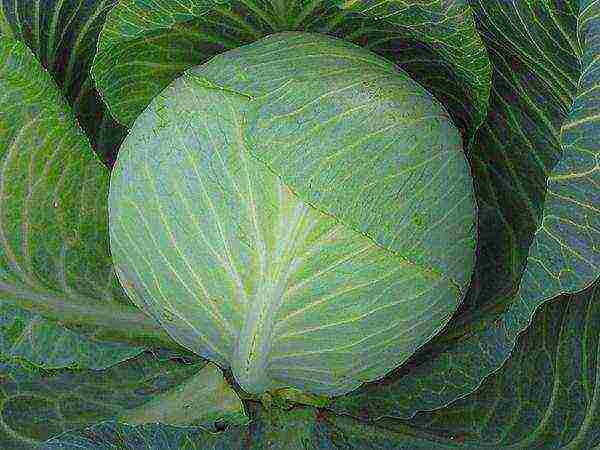 Valentine
Valentine
Gingerbread man - hybrid forms heads later 115-125 days after planting seedlings. Round fruits have a dense structure, the average weight is 2-3 kg. Planting scheme: 3-4 plants per 1 m2.
Due to its good immunity, it exhibits tolerance to punctate necrosis and thrips. For 8-10 months, cabbage retains its nutritional value and presentation.
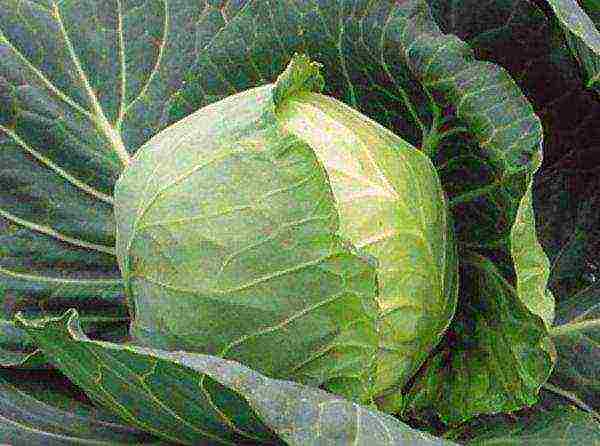 Gingerbread man
Gingerbread man
Mara - very dense heads are not susceptible to cracking, the average weight is 3 kg. The variety is distinguished by good taste, transportability and long shelf life (more than 7 months).
The main advantage is resistance to the accumulation of nitrates and radionuclides. Vegetables are harvested through 160-175 days after transplanting seedlings.
 Mara
Mara
Moscow - a variety developed by domestic breeders, who took into account the climatic features and possible problems with pests when growing.
Harvesting begins later 130-140 days after disembarking seedlings. Gray-green rounded heads of cabbage weigh 4-7 kg on average. When planting, the scheme is used: 2-3 plants per 1 m2.
Cabbage is resistant to cracking, has a delicate juicy pulp. Without loss of taste and presentation, the vegetable is stored for 6-8 months.
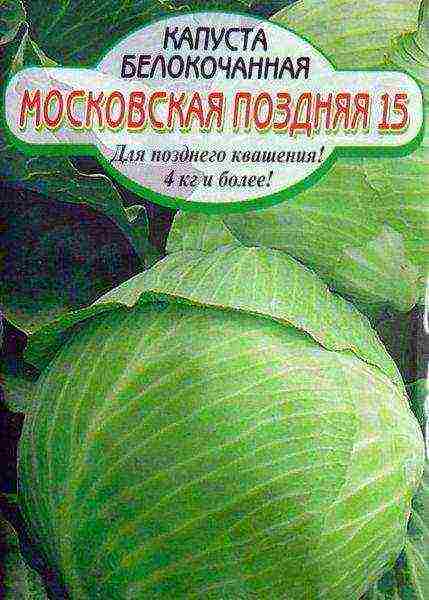 Moscow
Moscow
Mid-season white cabbage
Megaton - the hybrid matures in 102 days after planting seedlings. The great need for moisture and fertilizers strengthens the immune system, which resists many diseases and insect infestations.
The round-flattened gray-green head weighs up to 15 kg. The location of the holes when planting: 3 plants per 1 m2. Duration of storage without loss of nutritional qualities and presentable appearance is 4-6 months.
Merchant's wife - a disease-resistant high-yielding variety, distinguished by simple agricultural technology. About 500 centners are removed from a hectare (head weight up to 3 kg). When planting, the scheme is used: 3-4 plants per 1 m2.
Harvesting begins later 130-150 days after transferring seedlings to the beds.
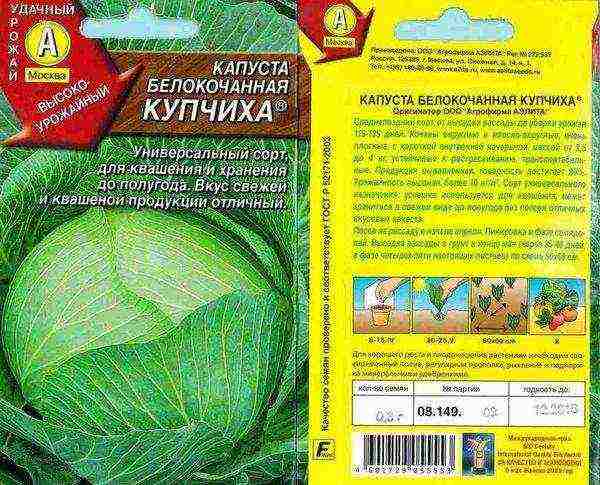 Merchant's wife
Merchant's wife
Atria - the fruit of the works of Dutch breeders with the growing season 110-120 days... The head of cabbage has a round-flat head of blue-green color, the average weight of which reaches 5-7 kg. Often there are specimens of 8-8.5 kg. When planting, the scheme is used: 3 plants per 1 m2.
Thanks to its good immunity, it resists pests (in particular thrips) and fusarium. The commercial and taste qualities are preserved for 4-6 months.
 Atria
Atria
Glory - the fruit of the work of Russian breeders, the growing season is 120-130 day after planting seedlings.
Round heads have a light green color with a grayish tinge, the weight tightens up to 3-5 kg. When planting, the holes are arranged according to the scheme: 3-4 plants per 1 m2.
The advantage of the variety is its taste, the disadvantage is short storage (about 2 months). Glory is one of the best pickling options.
 Glory
Glory
Sugar queen - the hybrid ripens after planting seedlings through 120-140 days... Dense rounded heads have a slightly greenish tint, weighing up to 4 kg.
When planting, the scheme is used: 3 plants per 1 m2. A universal variety, used fresh and for pickling. The shelf life without loss of valuable qualities is 3-4 months.
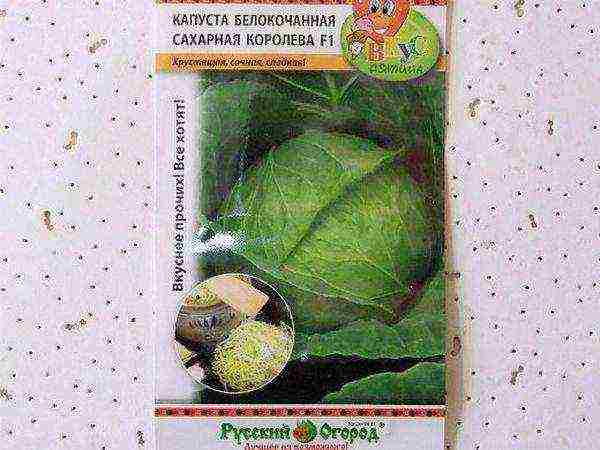 Sugar queen
Sugar queen
Early ripe
Rinda - the ripening period of the hybrid is 75-80 days after disembarking seedlings. Round heads weighing up to 7 kg have a green color and a dense structure. Hole layout: plant 3-5 plants per 1 m2. Differs in unpretentiousness to weather conditions.
The shelf life without loss of taste and presentation does not exceed 4 months.
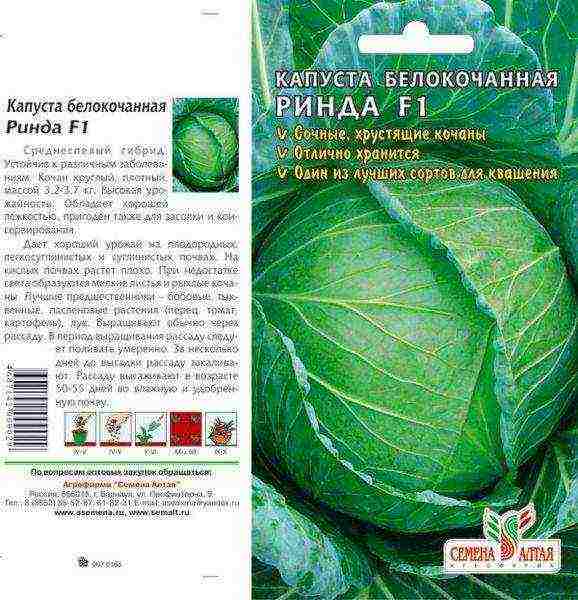 Rinda
Rinda
Kazachok - an early hybrid is distinguished by early maturity, you can harvest through 45-55 days after disembarking seedlings. The weight of the medium-sized light green head is 1.5 kg.
The scheme used for planting: 5-6 plants per 1 m2. Recommended for cultivation under any kind of film and in the open field. Cabbage resists the causative agents of mucous bacteriosis and black leg.
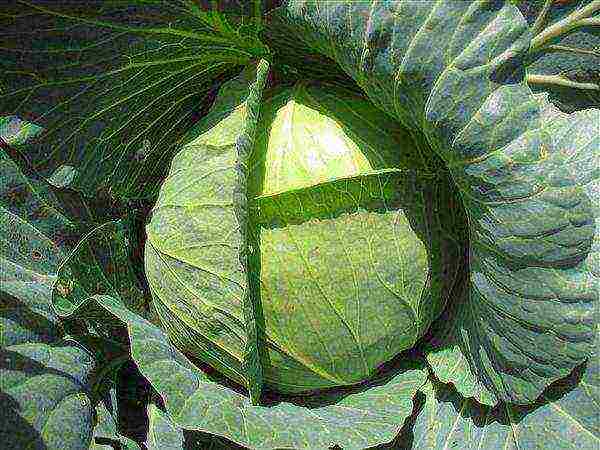 Kazachok
Kazachok
June - the variety is ready for planting in open ground already at the beginning of May, after 45-50 days you can harvest. The structure of the head is of medium density, the weight reaches 1.4-1.7 kg. When grown on highly fertile soils, the weight of the head of cabbage reaches 5 kg.
The layout of the holes when planting: 3-5 plants per 1 m2. Cabbage is distinguished by the amicability of the emergence of shoots and excellent taste.
 June
June
Tobia Is a Dutch hybrid characterized by resistance to fusarium wilt. The layout of the holes when planting: 2-3 plants per 1 m2. Dark green round-flat heads weigh up to 7 kg. Fruit ripening occurs later 85-90 days after disembarking seedlings.
It has a strong root system, if the irrigation regime is violated, the head of cabbage does not crack. It retains its taste and marketability for 5-6 months.
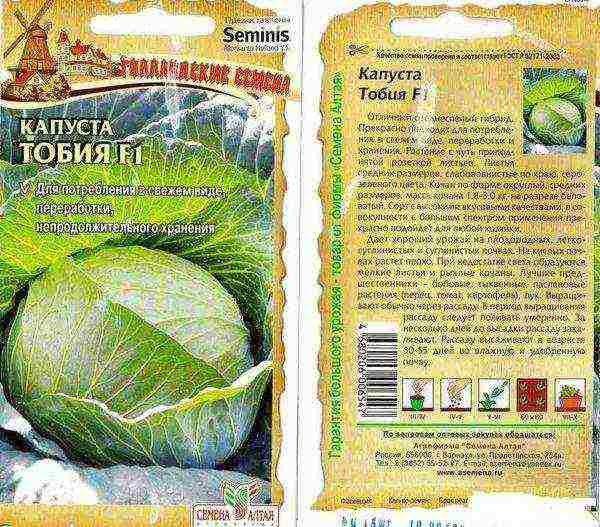 Tobia
Tobia
Varietal variety will ensure yields even in difficult weather conditions, because each plant has its own immunity to diseases and pests. The taste qualities of the varieties stimulate new experiments, which continue already in the kitchen.
Almost all gardeners grow cabbage on their plots. Its early varieties are intended mainly for fresh consumption, while the late ones are great for winter storage. If you create optimal or close conditions for the heads of cabbage, they will easily last until next summer, without losing their taste, density and juiciness. The choice of varieties and hybrids of late maturing cabbage, both Russian and foreign, is extremely wide. To decide, you need to study their advantages and disadvantages in advance.
The best varieties of late cabbage
The growing season for late varieties of cabbage is 140–180 days. The harvest is often harvested after the first frost, but this does not affect the quality of the heads of cabbage. The main advantages of varieties and hybrids of late ripening are high yield, keeping quality, transportability. Heads of cabbage are stored at least until spring, and at most until the next harvest, without losing in the least in presentability, benefits and taste. As a rule, these varieties have good immunity. And what is very important for Russian gardeners, most varieties of late cabbage are great for pickling and pickling.
There are many varieties and hybrids, but not all are popular.
Aggressor F1
Dutch breeding hybrid. The state register of the Russian Federation is recommended for cultivation in the Central region, but practice shows that it brings good harvests in the conditions of the Ural and Siberian climates. Belongs to the category of medium late, from the moment of emergence from seed to harvest, it takes 130–150 days.
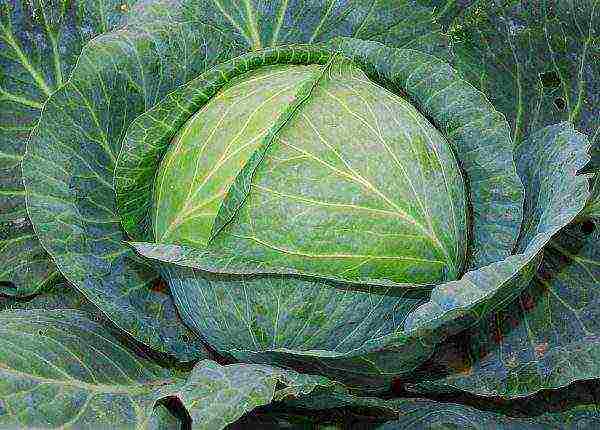 Cabbage Aggressor F1 consistently yields a crop, no matter what summer is in terms of weather
Cabbage Aggressor F1 consistently yields a crop, no matter what summer is in terms of weather
The socket is powerful, raised. The leaves are not too large, the central vein is strongly developed, because of this, they bend. The surface is finely bubbly, the edge is slightly corrugated. They are painted in a bright green shade with a grayish undertone, characterized by the presence of a layer of gray-silver plaque, reminiscent of wax.
Heads of cabbage are leveled, spherical, average weight - 2.5-3 kg. On the cut, white cabbage. The stump is not particularly large. The taste is not bad, the purpose is universal.
The F1 aggressor is valued by gardeners for the stability of fruiting (cabbage practically does not pay attention to the vagaries of the weather), a low percentage of heads of cabbage rejects (no more than 6–8% of non-marketable species), taste and resistance to fusarium. This is a dangerous disease that can destroy most of the crop both in the garden and during storage. Also, the hybrid successfully resists late blight, the "black leg". Aphids and cruciferous flea almost do not pamper him with their attention. Cabbage is unpretentious in care, does not make high demands on the quality and fertility of the substrate, heads of cabbage crack very rarely.
Video: what the cabbage Aggressor F1 looks like
Mara
One of the best achievements of Belarusian breeders. Heads of cabbage are formed in 165-175 days. They are dark green, covered with a thick layer of bluish-gray waxy coating, reaching a weight of 4–4.5 kg. The cabbage is very dense, but juicy. The total yield is 8-10 kg / m². It is an ideal choice for those who ferment their own cabbage.
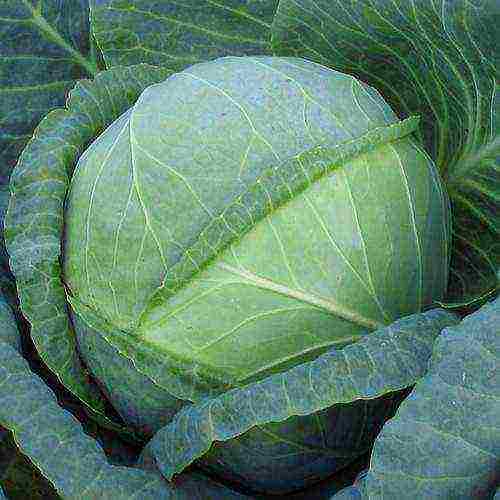 Mara cabbage is very good sauerkraut
Mara cabbage is very good sauerkraut
The keeping quality of the Mara variety is very good; under optimal conditions, it is stored until May next year. Another undoubted advantage is the presence of immunity to most types of rot. Heads of cabbage practically do not crack.
Moscow late
There are two varieties of this variety - Moscow late-15 and Moscow late-9. Both were bred quite a long time ago, the first - in the 40s of the last century, the second - 25 years later. There are almost no significant differences, except for the appearance of the outlet. Moscow late-15 has a very high stem, such cabbage is easy to weed, huddle and loosen. In the second variety, the rosette, on the contrary, is low, squat, it seems that the head of cabbage is lying directly on the ground. It is more difficult to look after her, but she is not amazed by the keel.
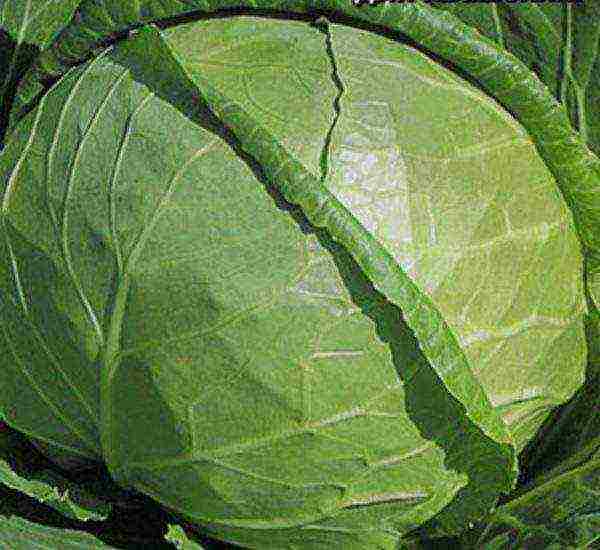 Cabbage Moscow late-15 is easy to care for - the heads of cabbage seem to stand on high legs
Cabbage Moscow late-15 is easy to care for - the heads of cabbage seem to stand on high legs
These cabbage varieties are recommended by the State Register for cultivation in the Far East, North-West, in the Central region. They are stored until the middle of next summer. They tolerate cold temperatures down to -8–10 ° C without much damage to themselves.
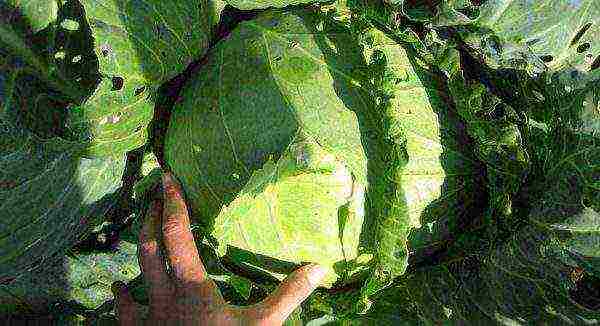 Cabbage Moscow late-9 is not affected by the keel
Cabbage Moscow late-9 is not affected by the keel
The leaves are large, broadly oval, wrinkled, with slightly corrugated edges. There is almost no wax coating. The heads of cabbage are slightly flattened, dense, yellowish on the cut, weighing on average 3.3–4.5 kg. But there are also “champions” weighing 8-10 kg. The marriage rate is very low - 3-10%.
Video: Moscow late cabbage variety
Amager 611
A fairly old medium-late variety of Soviet selection, it was included in the State Register back in 1943. There are no restrictions on the growing region. The ripening period of the crop is highly dependent on the weather, the growing season is 117-148 days.
The diameter of a rather powerful outlet is 70–80 cm.The leaves are slightly raised, can be almost round, and a very interesting shape, somewhat reminiscent of a lyre. The surface is almost smooth, even mild wrinkles are rare. The edge is also smooth. The leaves are covered with a thick layer of bluish bloom. The stem is rather high, 14-28 cm.
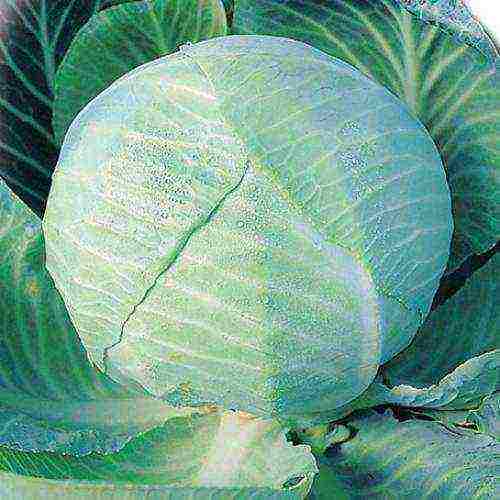 The taste qualities of Amager 611 cabbage cannot be called outstanding, its leaves are dryish and rough
The taste qualities of Amager 611 cabbage cannot be called outstanding, its leaves are dryish and rough
The average weight of a flattened head of cabbage is 2.6–3.6 kg. They practically do not crack. The taste cannot be called outstanding, and the leaves are rather coarse, but this cabbage is very good in salted and sauerkraut. Practice shows that during storage (Amager 611 can last until the middle of next spring) the taste improves. But this cabbage must definitely create optimal conditions, otherwise the development of gray rot, necrosis is very likely.
Snow White
It was bred back in the USSR, but now it is popular with gardeners. The growing season is 130–150 days. Differs in general unpretentiousness in care, is not affected by fusarium, during storage does not suffer from mucous bacteriosis. The only thing that she categorically does not tolerate is an acidic substrate.
The average weight of a pale green head of cabbage is 2.5–4.2 kg. The shape is almost round or slightly flattened. They are very dense but juicy. Fruiting is amicable, heads of cabbage rarely crack. This cabbage is notable for its transportability, it can be stored for at least 6–8 months, but provided that a constant temperature of at least 8 ° C is ensured.
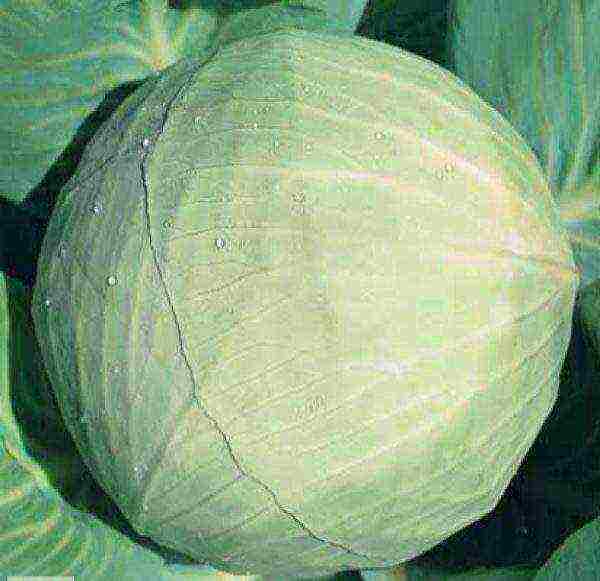 Snow White cabbage is not only delicious but also extremely healthy.
Snow White cabbage is not only delicious but also extremely healthy.
Snow White is prized mainly for its wonderful taste and high content of vitamins, micro- and macroelements. Moreover, the benefits are not lost when fermenting and salting. This cabbage is recommended to be included in the diet of children and the elderly.
Megaton F1
Another hybrid from the Netherlands that is often found on the personal plots of Russians. Among the late ones, it ripens one of the first. The growing season is 136–78 days.
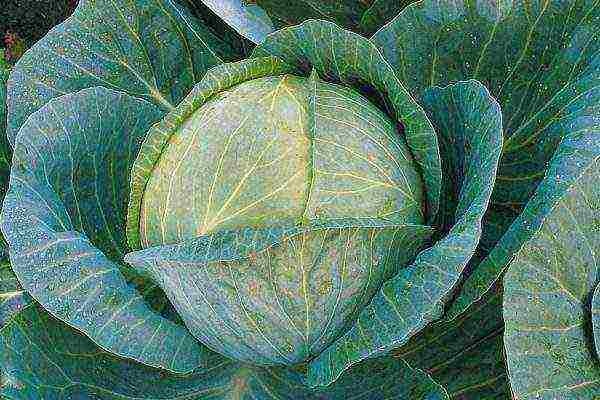 Cabbage Megaton F1 - one of the most popular Dutch hybrids in Russia
Cabbage Megaton F1 - one of the most popular Dutch hybrids in Russia
The outlet is spreading, powerful, squat. The leaves are large, pale green, almost round, concave due to the highly developed central vein, corrugated along the edge. There is a layer of wax coating, but not too noticeable.
The head of cabbage is also pale green, very dense, the stump is short. Average weight - 3.2-4.1 kg. The taste is wonderful, the yield is consistently high. The variety is immune to fusarium, rather rarely affected by keel and gray rot. Insects do not pay much attention to this cabbage either.
Video: what Megaton F1 cabbage looks like
Gingerbread man
Russian variety, bred in the mid-90s of the last century. There are no restrictions on the region of cultivation. The growing season is 145–150 days.
The rosette is raised, the stem is 30–34 cm high, very compact (45–55 cm in diameter). Leaves are broadly oval, deep green. The surface is smooth, along the edge there is a light wave. A layer of gray-gray waxy coating is thick, clearly visible.
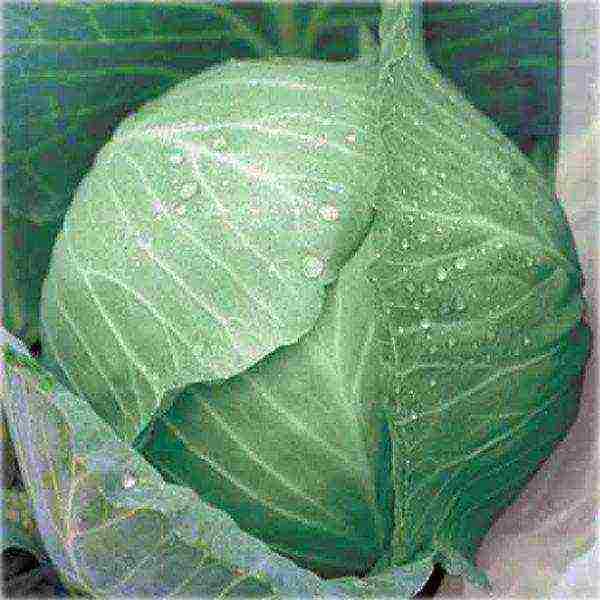 Fresh cabbage Kolobok is not very tasty, but during storage the situation is corrected
Fresh cabbage Kolobok is not very tasty, but during storage the situation is corrected
The head of cabbage is almost round, pale green on the cut. Average weight is about 5 kg. The taste is excellent. This cabbage cracks very rarely. The Kolobok is stored until May next year. It has immunity to the most dangerous diseases for culture - fusarium, mucous and vascular bacteriosis, all types of rot. Fresh cabbage is almost never eaten - immediately after cutting it has a bitter taste that disappears during storage.
Wintering 1474
Soviet variety specially created for storage. Even in far from optimal conditions, this cabbage will last at least until mid-winter. If it is stored correctly, in January-February they just start eating it. During this time, the palatability improves significantly, the heads of cabbage seem to gain juiciness.The state register is recommended for cultivation in the Volga region and the Far East.
 Cabbage variety Zimovka 1474 was bred specifically for long-term storage
Cabbage variety Zimovka 1474 was bred specifically for long-term storage
The socket is not particularly powerful, slightly raised. The leaves are ovoid, large, painted in a grayish-green color, covered with a thick layer of waxy bloom. The surface of the lamina is moderately wrinkled, the edges are noticeably corrugated.
The average weight of a head of cabbage is 2–3.6 kg. They are slightly flattened, with a rather long stump. The percentage of non-commercial products is no more than 2–8%. Cabbage does not crack and does not suffer from necrosis during storage.
Languadeaker
An old variety, proven by more than one generation of gardeners, bred in Holland. The growing season is 150-165 days. It is appreciated for its excellent taste, which only improves during storage, resistance to most common cabbage diseases (especially bacteriosis), keeping quality and ability to tolerate transportation well. The purpose is universal. This cabbage is good both fresh and homemade.
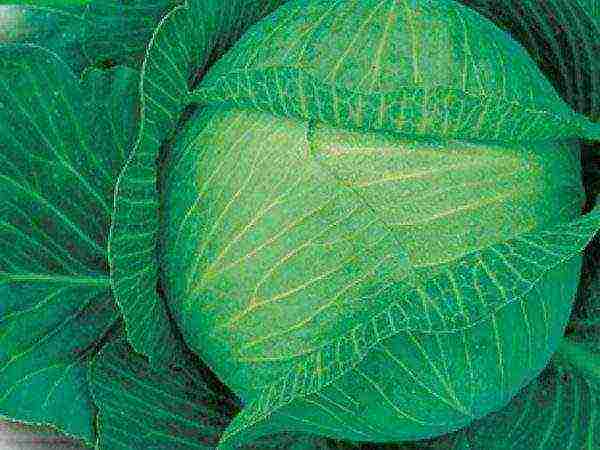 Languedaker is a variety of cabbage grown not only at home, but all over the world
Languedaker is a variety of cabbage grown not only at home, but all over the world
Dark green dense broad-oval heads of cabbage do not crack. This also applies to those that are fully ripe, but not yet harvested. The average weight of cabbage is 3.5–5 kg. 9-10 kg are removed from 1 m². Langedeiker tolerates prolonged drought and heat well, is able to "forgive" the gardener for improper watering.
Turkiz
German variety from the late category. The crop is harvested 165–175 days after mass germination. Heads of cabbage are stored for at least 6-8 months, do not crack in the process, extremely rarely become infected with pathogenic fungi. Plants also rarely get sick in the open field, demonstrating the presence of an "innate" immunity to phomosis, carinae, fusarium wilt and all types of bacteriosis. In comparison with other varieties, the variety is drought-resistant.
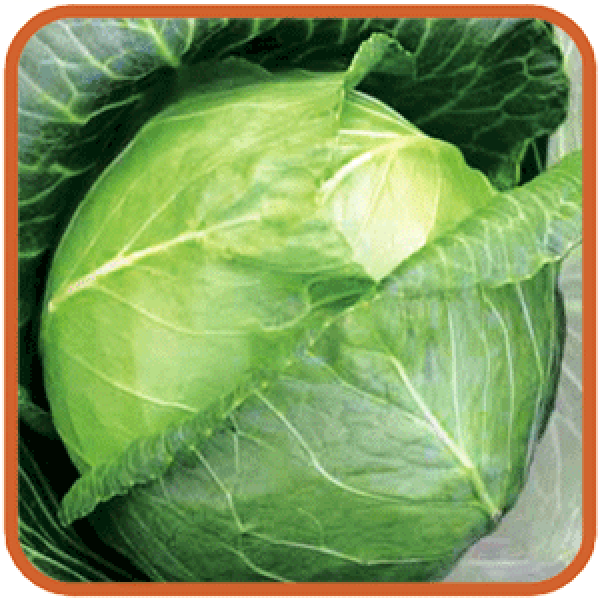 Turkiz cabbage is valued for its good drought resistance
Turkiz cabbage is valued for its good drought resistance
Heads of cabbage are medium in size (2-3 kg), regular round shape, dark green. The total yield is 8-10 kg / m². The taste is very good, sweetish, the cabbage is juicy. Sauerkraut is very good.
Kharkov winter
The variety, as it is easy to understand, comes from Ukraine. I got into the State Register in 1976. The purpose of cabbage is universal - it is good fresh, in homemade preparations, it is also suitable for storage (it will last up to 6-8 months). Ripens in 160-180 days.
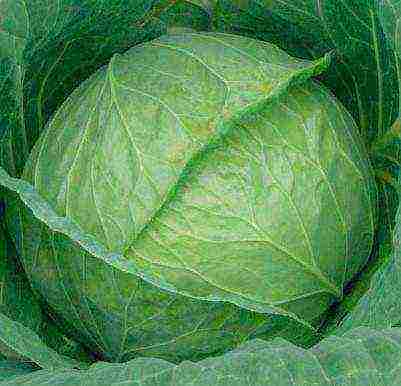 Kharkiv winter cabbage during storage does not become infected with bacteriosis
Kharkiv winter cabbage during storage does not become infected with bacteriosis
The rosette is slightly raised, spreading (diameter 80–100 cm), the leaves are elliptical, almost smooth, only a light wave goes along the edge. A thick layer of waxy coating is characteristic. Heads of cabbage are flattened, weighing 3.5–4.2 kg. The taste is excellent, the defect rate is low (no more than 9%).
The variety tolerates both low and high temperatures well (from -1–2 ° C to 35–40 ° C), and is distinguished by drought resistance. During storage, heads of cabbage do not become infected with necrosis and mucous bacteriosis. 10-11 kg are obtained from 1 m². Ripe cabbage can not be cut until the first frost - it will not crack or deteriorate.
Mom F1
A hybrid, which the State Register advises to cultivate in the Volga region. Heads of cabbage are not particularly dense, but keep well for up to six months. The growing season is 150–160 days.
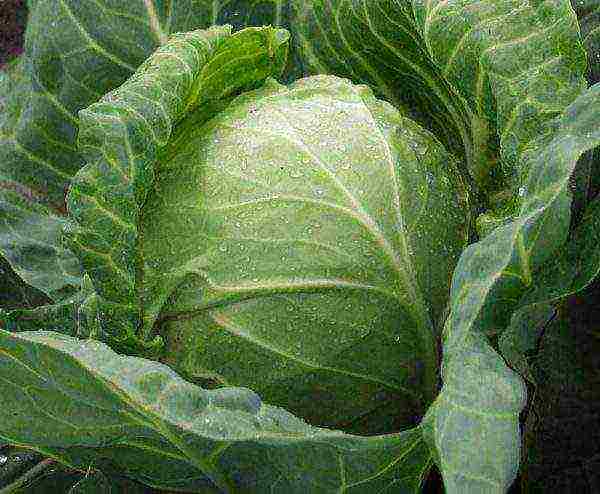 Cabbage Mama F1 does not differ in the density of heads, but this does not affect keeping quality
Cabbage Mama F1 does not differ in the density of heads, but this does not affect keeping quality
The socket is slightly raised. Leaves are medium-sized, grayish-green, covered with a light layer of waxy bloom. The surface is almost smooth, slightly bubbly, the edges are even. Heads of cabbage are slightly flattened, pale green on the cut, leveled (average weight 2.5–2.7 kg). The marriage rate is low - up to 9%.
Valentine F1
The hybrid was bred relatively recently, quickly won the love of Russian gardeners. The growing season is 140–180 days. Resistant to fusarium wilt. There are few heads of non-marketable type, no more than 10%. Shelf life is 7 months or more.
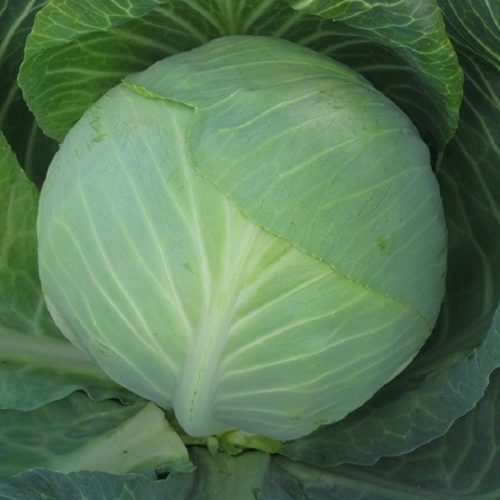 Valentina F1 cabbage is a relatively recent achievement of breeders, but gardeners quickly appreciated it.
Valentina F1 cabbage is a relatively recent achievement of breeders, but gardeners quickly appreciated it.
The rosette is quite powerful, but the leaves are medium-sized, of a grayish-green hue. The surface is almost smooth, covered with a thick layer of gray waxy coating.
Heads of cabbage are medium in size, weighing 3.2-3.8 kg, ovoid, white-green on the cut. It is characterized by a very high density and a small stump. The taste is simply wonderful, the cabbage is crispy and sugary. An excellent choice for fermentation.
Sugar Loaf
The variety is recommended by the State Register for cultivation in Western Siberia, it is distinguished by its versatility of purpose. Shelf life is at least 8 months. The growing season is 160-165 days.
The socket is raised, powerful. The leaves are large, dark green with a grayish tint, the wax coating is not too noticeable. The surface is almost even, only slight "bubbling" and corrugation along the edge are characteristic.
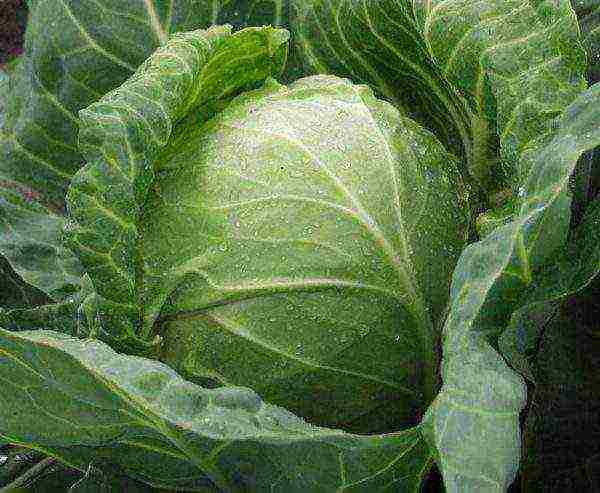 Sugarloaf cabbage does not even have a slight bitterness
Sugarloaf cabbage does not even have a slight bitterness
Heads of cabbage are spherical, white-green on the cut. The stump is very short. Average weight - 2.2-2.8 kg. They do not differ in special density, but this does not affect keeping quality. The percentage of marketable products is 93%. The variety is appreciated not only for its excellent taste and complete absence of bitterness. Among its undoubted advantages is resistance to keel, fusarium wilt and bacteriosis.
Orion F1
The state register recommends growing this hybrid in the North Caucasus. It takes 165-170 days for the heads of cabbage to ripen.
The rosette is vertical, low (35–40 cm), rather compact (68–70 cm in diameter). The leaves are almost round, with very short petioles. The stem is 18–20 cm high. The heads of cabbage are elongated, very dense, weighing about 2.3 kg. On the cut, the cabbage is creamy white. Good taste, as well as keeping quality. Until May next year, 78–80% of heads of cabbage are preserved.
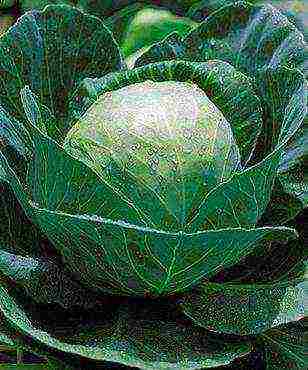 Orion F1 cabbage - these are medium-sized, but very dense heads of cabbage
Orion F1 cabbage - these are medium-sized, but very dense heads of cabbage
The hybrid successfully resists bacteriosis, somewhat worse - fusarium. The crop yields consistently, no matter how lucky the gardener is with the summer weather. Heads of cabbage practically do not crack, ripen together.
Lennox F1
A hybrid originally from Holland. Restrictions regarding the region of cultivation are not established by the State Register. Cabbage is good both fresh and after long-term storage. Heads of cabbage ripen in 167-174 days. Shelf life - up to 8 months. This cabbage, thanks to its powerful root system, tolerates drought well.
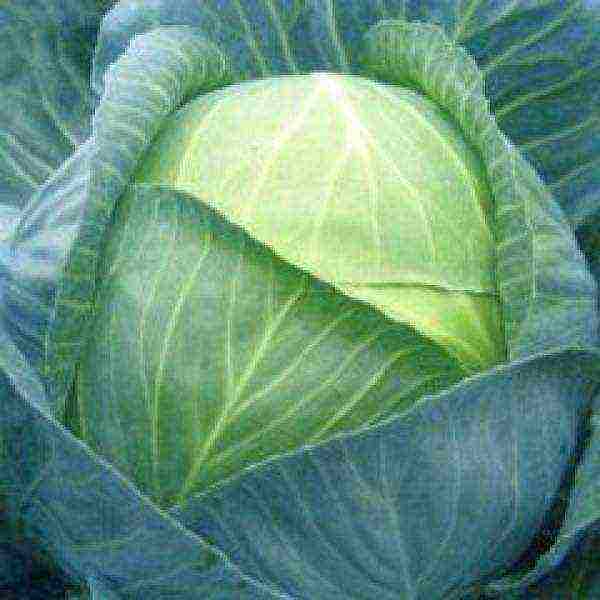 Cabbage Lennox F1 stands out for its good drought resistance
Cabbage Lennox F1 stands out for its good drought resistance
The socket is quite compact. The leaves are large, ovoid, grayish-green with a lilac tint, concave along the central vein. The surface is finely wrinkled, the edges are even. The presence of a thick waxy coating is characteristic. Heads of cabbage are spherical, weighing 1.6–2.4 kg, very dense. The total yield is 9-10 kg / m². The hybrid is valued for its sugar content, it has a high vitamin C content.
Video: an overview of popular varieties of late cabbage
Recommendations for growing a crop
Caring for late cabbage is not much different from growing other varieties. The main nuances are related to the length of the growing season. Heads of cabbage take longer to ripen and require more nutrients.
Planting procedure and preparation for it
Since it takes about five to six months from the moment the seedlings emerge to the maturation of the heads of cabbage for most varieties of late-ripening cabbage, in a temperate climate it is grown exclusively by seedlings. Seeds in Russia can be planted directly into the ground only in southern regions with a subtropical climate.
Modern varieties and hybrids have good immunity, but in general, cabbage is prone to damage by pathogenic fungi. To avoid this, the seeds undergo special training before planting. For disinfection, they are immersed in hot (45–50 ° C) water for a quarter of an hour, then in cold water for just a couple of minutes.Another option is etching in a fungicide of biological origin (Alirin-B, Maxim, Planriz, Ridomil-Gold) or in a bright pink solution of potassium permanganate. To increase germination, use any biostimulants (potassium humate, Epin, Emistim-M, Zircon). The solution is prepared according to the manufacturer's instructions, the seeds are immersed in it for 10-12 hours.
 A solution of potassium permanganate is one of the most common disinfectants, soaking cabbage seeds in it is an effective prevention of fungal diseases
A solution of potassium permanganate is one of the most common disinfectants, soaking cabbage seeds in it is an effective prevention of fungal diseases
The optimal time for planting late cabbage for seedlings is late March or early April. The seedlings are transferred to the ground in the first half of May, the harvest is harvested in October. In the southern regions, all these dates are postponed 12-15 days ago. These varieties and hybrids are not afraid of autumn frosts, negative temperatures do not affect keeping quality.
Any cabbage tolerates transplanting and picking very badly. Therefore, it is immediately planted in small peat pots. Soil is a mixture of humus, fertile soil and sand in approximately equal proportions. For the prevention of fungal diseases, add a little crushed chalk or wood ash. Before planting, the substrate is well moistened. The seeds are buried 1–2 cm, sprinkled on top with a thin layer of fine sand.
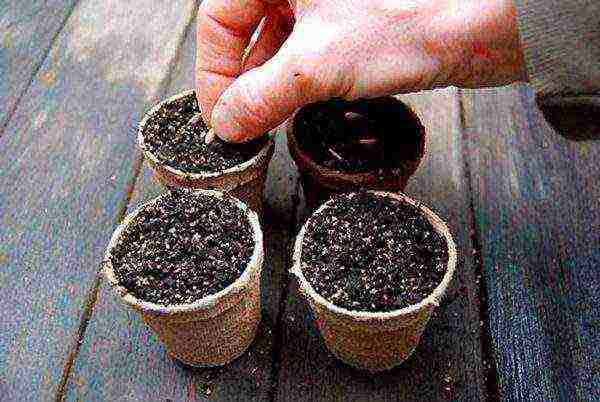 Cabbage planted in peat pots can be transferred to the garden without removing it from the container
Cabbage planted in peat pots can be transferred to the garden without removing it from the container
Until emergence, containers are kept in a dark, warm place under a film or glass. As a rule, seeds germinate in 7-10 days. Seedlings need to be provided with 10-12 hours of daylight. The temperature in the first 5–7 days is lowered to 12–14 ° C, then raised to 16–18 ° C. The substrate is constantly maintained in a moderately moist state, but not poured (this is fraught with the development of a "black leg").
 For proper development, cabbage seedlings require a sufficiently low temperature.
For proper development, cabbage seedlings require a sufficiently low temperature.
In the phase of the second true leaf, cabbage is fed with mineral nitrogen fertilizers (2-3 g per liter of water). A week later, it is watered with a solution of a complex seedling agent (Rostock, Solution, Kristalin, Kemira-Lux). About a week before transplanting, cabbage begins to harden, making it easier for it to adapt to new conditions. Seedlings ready for planting reach a height of 17–20 cm and have 4–6 true leaves.
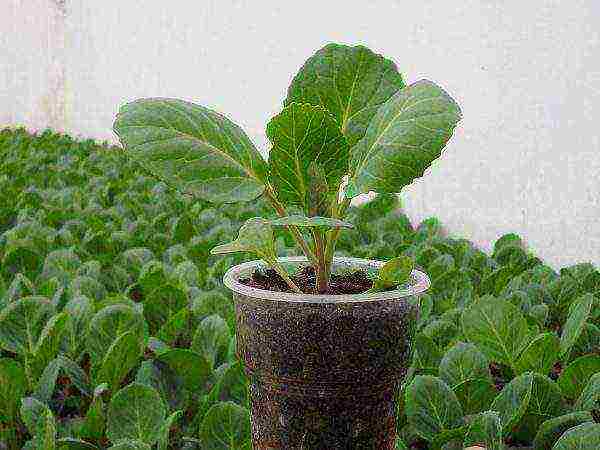 Do not hesitate to plant cabbage seedlings in the ground: the older the plant, the worse it takes root in a new place
Do not hesitate to plant cabbage seedlings in the ground: the older the plant, the worse it takes root in a new place
Video: growing cabbage seedlings
The garden bed is prepared in advance, choosing an open place. Even a light partial shade is not suitable for the culture. Due to the high humidity of the air and soil, any lowlands are excluded. Do not forget about crop rotation. Cabbage grows best after beets, herbs, legumes and nightshades. Cruciferous relatives are undesirable as predecessors.
 For growing cabbage, choose an open place well warmed by the sun.
For growing cabbage, choose an open place well warmed by the sun.
Cabbage needs light, but nutritious soil. She categorically does not tolerate an acidic and salty substrate. When digging into the soil, humus or rotted compost, dolomite flour, phosphorus and potassium fertilizers are necessarily introduced (can be replaced with sifted wood ash). In the spring, 10-15 days before planting, the bed is loosened well and mineral nitrogen fertilizers are added.
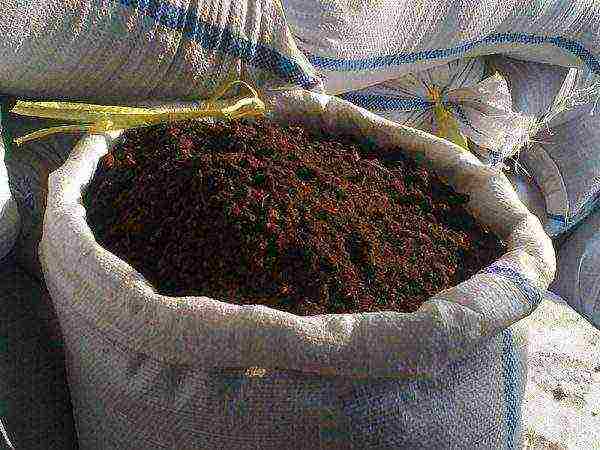 Humus is an effective remedy for increasing soil fertility
Humus is an effective remedy for increasing soil fertility
The wells are well spilled before planting the cabbage. It is imperative to adhere to the planting scheme (at least 60 cm between plants and 60–70 cm between rows) so that each head of cabbage has sufficient area for nutrition. The seedlings are transferred to a permanent place along with the pot. A little humus, a teaspoon of superphosphate and onion peel are placed at the bottom of the hole to repel pests. The cabbage is buried to the first pair of leaves, once again watered abundantly, mulched. Until it starts to grow, a canopy of white covering material is erected over the garden bed.Or each seedling is separately covered with spruce branches, paper caps.
 Cabbage seedlings are planted in holes abundantly spilled with water, practically in the "mud"
Cabbage seedlings are planted in holes abundantly spilled with water, practically in the "mud"
In open ground, seeds of late cabbage are planted in late April or early May. The ground at a depth of 10 cm should warm up to at least 10–12 ° C. When planting, follow the scheme, put 3-4 seeds in each hole. Sprinkle them on top with peat chips or humus (a layer 2-3 cm thick).
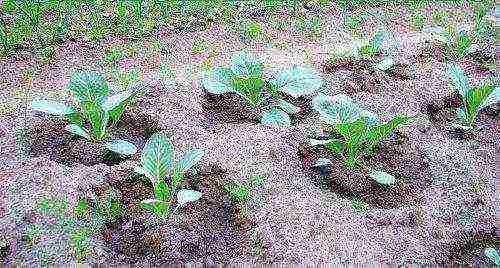 Cabbage (both seeds and seedlings) is planted in the ground, providing the plants with sufficient area to feed
Cabbage (both seeds and seedlings) is planted in the ground, providing the plants with sufficient area to feed
Before the emergence of shoots, the bed is covered with plastic wrap. Then - tighten the covering material on the arcs. After a month, the shelter can be removed for a day, after another 1.5–2 weeks - removed completely. In the phase of the second true leaf, culling is carried out, leaving one seedling in each hole. "Unnecessary" cut with scissors or pinch at the very ground.
 In open ground, seeds of late cabbage are planted only if the climate in the region allows
In open ground, seeds of late cabbage are planted only if the climate in the region allows
Water the seedlings in moderation. Plain water can be alternated with a pale pink potassium permanganate solution. To protect against fungal diseases, cabbage is powdered with crushed chalk or colloidal sulfur. Sprinkle the soil in the garden with a mixture of ash, tobacco chips and ground pepper. This will help ward off many pests.
Further care
Late cabbage, like its other varieties, is regularly loosened, the garden is weeded. With loosening, you need to be very careful not to go deeper than 10 cm. About three weeks after planting, it is huddled to stimulate the development of more adventitious roots. The procedure is repeated after another 10-12 days and just before the leaves close into a continuous carpet. The shorter the stem, the more often you need to spud the plants.
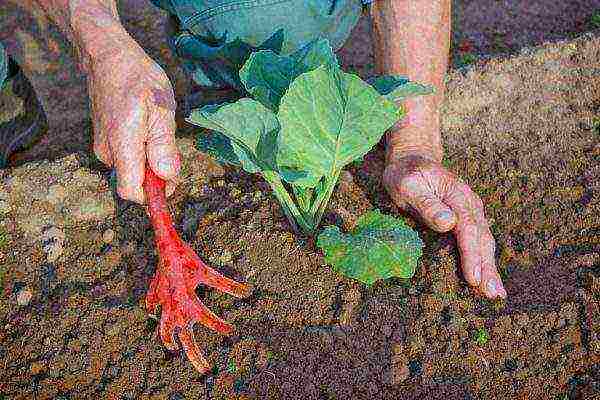 Ideally, the cabbage bed should be loosened after each watering - this promotes aeration of the roots, prevents moisture from stagnating in the soil
Ideally, the cabbage bed should be loosened after each watering - this promotes aeration of the roots, prevents moisture from stagnating in the soil
The main component of cabbage care is proper watering. It needs moisture especially strongly during August, during the formation of heads of cabbage. Freshly planted seedlings are watered every 2-3 days, consuming 7-8 liters of water per 1 m². After 2-3 weeks, the intervals between procedures are doubled, and the norm - up to 13-15 l / m². The soil must be soaked to a depth of at least 8 cm. Of course, the frequency of watering is highly dependent on the weather. In hot weather, cabbage is watered daily or even twice a day, early in the morning and late in the evening. You can also spray the leaves and heads of cabbage additionally.
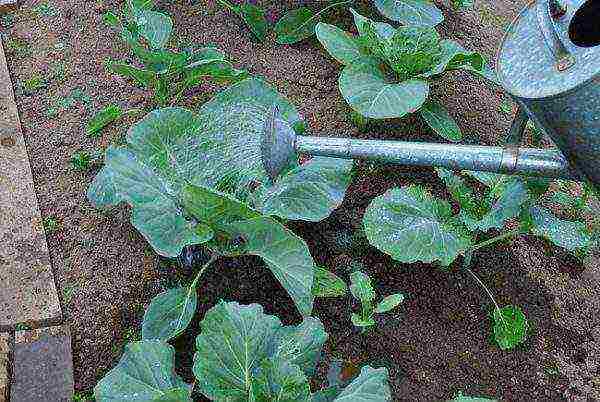 Cabbage is a moisture-loving culture, this applies to both newly planted seedlings and adult plants
Cabbage is a moisture-loving culture, this applies to both newly planted seedlings and adult plants
It is undesirable to pour water directly under the roots. They are located in cabbage very close to the soil surface, quickly become bare and dry out. Better to water it using the grooves in the aisles. If technically feasible, sprinkler irrigation is organized (his cabbage is very fond of it) and drip irrigation. These methods allow you to evenly wet the soil.
It is categorically impossible to alternate long periods of drought with rare very abundant watering. This is the main cause of head cracking.
About a month before harvesting, watering is reduced to the required minimum. In this case, cabbage will become juicier, pick up the sugar content inherent in the variety.
The growing season for late cabbage is long, so it needs more feeding per season than varieties of early and medium ripening. Begin to apply fertilizers simultaneously with the first hilling. Any nitrogen-containing products are suitable - ammonium sulfate, carbamide, ammonium nitrate. They are embedded in the ground at the rate of 10-15 g / m² or diluted in 10 liters of water. After a month, the procedure is repeated.
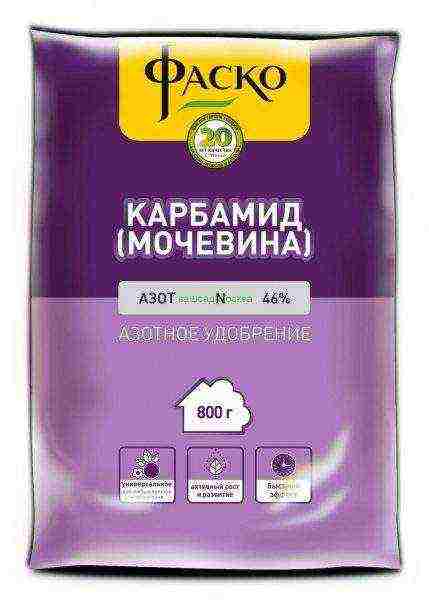 Urea, like other nitrogen-containing fertilizers, stimulates cabbage to actively build up green mass
Urea, like other nitrogen-containing fertilizers, stimulates cabbage to actively build up green mass
Cabbage has a very positive attitude to any organic fertilizers.An excellent top dressing is an infusion of fresh cow dung, bird droppings, nettle greens, dandelion leaves. Cabbage is watered with it two to three times during the summer at intervals of a month. Before use, the infusion must be filtered and diluted with water in a ratio of 1:15 (if it is a litter) or 1:10 when using any other raw material. Complex fertilizers are no worse - Multiflor, Pure Leaf, Gaspadar, Agricola, Zdraven.
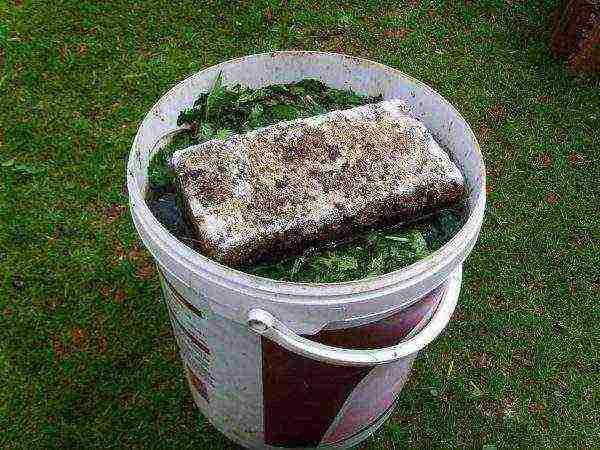 Nettle infusion is a very useful and absolutely natural fertilizer
Nettle infusion is a very useful and absolutely natural fertilizer
Nitrogen is necessary for cabbage, but only in the first half of the growing season. In this case, it is worth strictly observing the recommended dosage. Its excess negatively affects the immunity of the plant, contributes to the accumulation of nitrates in the leaves.
As soon as the head of cabbage begins to form, they switch to potash and phosphorus fertilizers. Before harvesting, late cabbage is watered 1-2 times with a solution of superphosphate and potassium sulfate (25-30 g per 10 l of water). Or you can add wood ash to the base of the stem every 1.5–2 weeks. An infusion is prepared from it (a half-liter jar for 3 liters of boiling water).
 Wood ash is a natural source of potassium and phosphorus, especially necessary for late cabbage during the maturation of cabbages
Wood ash is a natural source of potassium and phosphorus, especially necessary for late cabbage during the maturation of cabbages
Do not forget about foliar feeding. Cabbage especially reacts negatively to the deficiency of boron and molybdenum in the soil. During the season, it is sprayed 2-3 times with a solution of trace elements - 1-2 g of potassium permanganate, zinc sulfate, copper sulfate, boric acid, ammonium molybdenum per liter of water.
Video: caring for late cabbage after planting in the ground
The crop is harvested only after reaching full maturity. Unripe heads of cabbage are stored much worse. Most varieties and hybrids tolerate slight negative temperatures without damage to themselves, so it is better to wait with harvesting. Most often, late cabbage ripens in the first half of October, less often at the end of September.
Experienced gardeners 2-3 weeks before harvest are advised to chop the stem, cutting it by about a third, and slightly loosen the plant in the soil. The heads of cabbage will no longer be supplied with nutrients, grow in size and will definitely not crack.
Cabbage must be pulled out with roots. You can even store it right there by "transplanting" it into a box with wet peat or sand. But in this case, it takes up quite a lot of space.
Heads of cabbage intended for long-term storage are carefully examined, rejecting those on which even the slightest suspicious damage is noticeable. The stump is cut with a sharpened clean knife, leaving at least 4–5 cm. Two or three integumentary leaves do not need to be removed either. All sections are processed by sprinkling with activated carbon powder, colloidal sulfur, cinnamon.
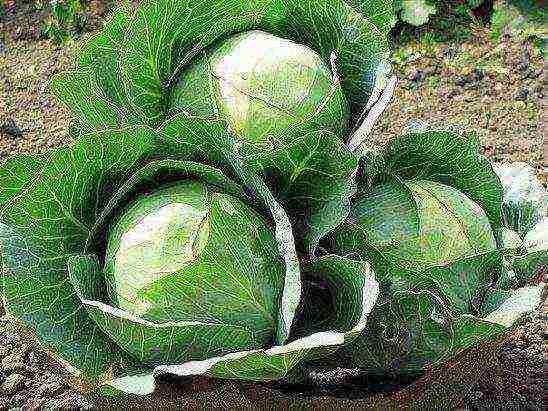 Cabbage for long-term storage is carefully selected
Cabbage for long-term storage is carefully selected
Before laying the cabbage for storage, the cellar or basement must be disinfected by wiping all surfaces with a solution of slaked lime. Heads of cabbage in one layer are laid out on shelves covered with shavings, sawdust, straw, sand, and scraps of newsprint so that they do not come into contact with each other. To prevent the development of fungal diseases, it is recommended to dust them with crushed chalk or wood ash.
To save space, the heads of cabbage are tied by stumps in pairs and hung on a wire or rope stretched from the ceiling. In this case, it is also desirable that they do not touch each other.
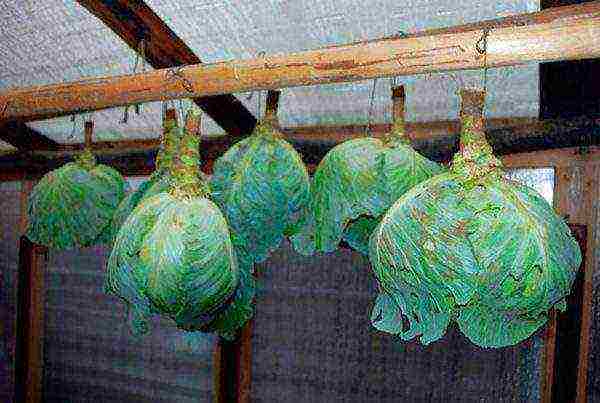 This unusual way of storing cabbage saves space in the cellar.
This unusual way of storing cabbage saves space in the cellar.
Even the best varieties and hybrids of late cabbage will not last long if not provided with suitable conditions. Cabbage is stored in a dark place with good ventilation at a temperature of 2–4 ° C and an air humidity of 65–75%.
Video: cabbage harvest and storage
Gardeners reviews
You have to wait a long time for the harvest of late cabbage, but this is more than compensated by the keeping of the heads of cabbage.Crop care has its own nuances, which you need to know about in advance, but there is nothing difficult in growing late-ripening varieties and hybrids. Often the most difficult choice for the gardener is the choice. After all, the area of the site is limited, and there are a lot of varieties of culture. And each has its own indisputable merits.
27 years old, higher education in law, broad outlook and interest in a variety of topics.

